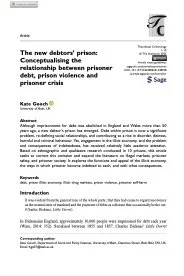By Nancy Rodriguez, H. Daniel Butler, Natasha Frost, Melinda Tasca, and Jillian Turanovic
This policy brief presents the findings of our multi-strategy approach, spearheaded by the Prison Violence Consortium, to examine the sources and consequences of prison violence. We capture prison violence using data on guilty violent infractions, violent incident reports, and interviews with incarcerated persons and correctional employees. We offer solution-driven recommendations to policymakers, institutional leaders, prison researchers, and other stakeholders, aiming to enhance prison safety and more effectively address institutional violence nationwide..
Key Findings ● Perpetrators of Violence & Timing: ● Prison violence was concentrated among a small subset of persons, as 10% of the population accounted for more than 50% of guilty violent infractions. ● Personal characteristics related to guilty violent infractions included younger age at admission, lower education, longer sentences, violent criminal histories, gang affiliations, and greater mental health needs. ● Most people (63%) committed guilty violent infractions within 6-12 months of admission, with fewer than 10% remaining violent throughout their incarceration. ● Common Forms & Situational Factors: ● Most violence (71%) occurred between incarcerated persons, while 29% was directed at staff, according to the incident reports. ● The most prevalent form of violence was fights between persons (38%), followed by assaults on persons (26%), assaults on staff (17%), biohazard incidents (13%), and unwitnessed physical altercations (6%). ● Violence most often occured in cells or housing areas (39%) and common areas (e.g., cafeteria and yard) (31%). ● Weapons and contraband were mentioned in 10% of the incident reports.
Irvine, CA: UC Irvine School of Social Ecology, Prison Violence Consortium, 2024. 23p.




















